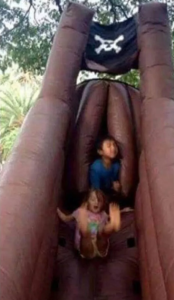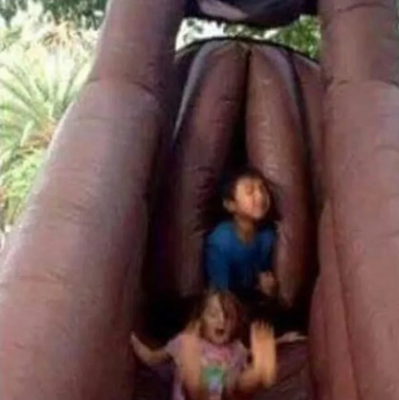
The Dirty Mind Illusion: Why We See What Isn’t There
We live in a world shaped by perception — not just what we see, but how we interpret it. And nothing proves this more hilariously than the genre of “look twice” photos: those perfectly timed, innocently framed images that seem scandalous at first glance, only to reveal their true nature upon closer inspection. A woman appears to be naked in public — until you realize it’s a flesh-colored dress. A man seems to be grabbing something inappropriate — until you notice it’s just a shadow. These images don’t lie. Our minds do.
But why?
🧠 The Psychology of Suggestion
Our brains are wired for speed. In a fraction of a second, we scan an image, compare it to familiar patterns, and make a judgment. This is evolutionary efficiency — a survival mechanism that helps us react quickly to danger or opportunity. But it also means we’re prone to shortcuts, especially when it comes to taboo or emotionally charged content.
Sexual imagery, for example, is processed rapidly and with heightened sensitivity. It’s not just cultural conditioning — it’s biological. The human brain is primed to detect reproductive cues, even when they’re not actually present. That’s why a fold in a curtain or the curve of a shadow can trigger a moment of confusion, even embarrassment. We’re not perverts. We’re just perceptually vulnerable.
👀 The Art of the Misleading Image
“Look twice” photos are a kind of visual prank. They exploit the tension between expectation and reality. A dog’s nose poking through a blanket looks like a human body part. A man standing behind a statue appears to be doing something indecent. A woman holding a seashell seems to be revealing more than she is. These images are innocent — until your imagination gets involved.
And that’s the point. They’re not dirty. You are. Or rather, your brain is playing tricks on you.
This genre of humor thrives on ambiguity. It invites the viewer to participate in the illusion, to experience the moment of misrecognition and then laugh at their own mistake. It’s a shared joke — one that relies on the universal experience of cognitive bias.
🔍 The Double Take: A Moment of Self-Reflection
There’s something deeply human about the double take. It’s not just about correcting a visual error. It’s about confronting the assumptions that led to it. When we look twice, we’re not just seeing more clearly — we’re acknowledging that our first impression was flawed. And that’s a powerful metaphor.
In life, we often judge too quickly. We see someone’s appearance, hear a snippet of conversation, or read a headline, and we form an opinion. But reality is rarely that simple. Just like the misleading photo, people and situations deserve a second look.
The “dirty mind” illusion becomes a mirror. It reflects not just our perceptual habits, but our cultural taboos, our biases, and our capacity for self-awareness. It’s funny — but it’s also revealing.
🎭 Humor, Shame, and the Social Lens
Why do we laugh when we’re fooled by a look-twice image? Part of it is relief. We realize we haven’t witnessed something inappropriate, and we’re off the hook. But part of it is shame — the recognition that our minds went somewhere they weren’t supposed to.
This tension between humor and discomfort is what makes the genre so compelling. It’s not just visual trickery. It’s psychological theater. We’re watching ourselves react, and then laughing at the reaction.
In a way, these images are social tests. They reveal how we’ve been conditioned to interpret certain shapes, colors, and contexts. They expose the cultural scripts we carry — about nudity, propriety, and sexuality. And they do it with a wink.
🧵 Threads of Innocence and Suggestion
There’s a deeper layer to this, too. The best “look twice” photos don’t just trick the eye — they tell a story. They invite the viewer to imagine a scenario, to fill in the blanks, and then to revise that story when the truth is revealed.
This narrative quality is what makes them so shareable. They’re not just images. They’re moments of transformation. And transformation, as you know well, Phirun, is the heart of storytelling.
Whether it’s a grandmother confronting ageism or a stranger revealing hidden kindness, the power of narrative lies in its ability to shift perspective. And these photos — silly as they are — tap into that same dynamic. They start with misunderstanding and end with clarity. They begin with discomfort and end with laughter.
🖼️ The Innocent Trickster
In mythology, the trickster is a figure who disrupts norms, exposes hypocrisy, and reveals hidden truths. Loki, Anansi, Coyote — these characters use mischief to teach lessons. And in a way, “look twice” photos are modern tricksters. They play with our expectations, challenge our assumptions, and remind us not to take ourselves too seriously.
They’re not just jokes. They’re provocations. They ask: What did you think you saw? Why did you think that? And what does that say about you?
🌐 A Global Language of Misinterpretation
What’s fascinating is that this genre transcends culture. Whether you’re in Cambodia or Canada, Tokyo or Texas, the illusion works. The human brain is universally susceptible to visual suggestion. And the laughter that follows is just as universal.
In a world often divided by language, politics, and belief, these images offer a moment of shared experience. We all misjudge. We all laugh. We all look twice.
💬 Final Glance: The Power of Perspective
So next time you see a photo that makes you gasp, pause. Look again. And then smile — not just at the clever framing, but at your own wonderfully flawed perception.
Because in that moment, you’re not just seeing an image. You’re seeing yourself.
And that, Phirun, is the real magic.



